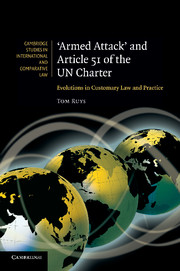Book contents
- Frontmatter
- Contents
- Acknowledgment
- Table of abbreviations and abbreviated citations
- Selected case law, legislation and related documents
- Introduction
- 1 The methodological debate and the quest for custom
- 2 ‘Armed attack’ and other conditions of self-defence
- 3 The ‘armed attack’ requirement ratione materiae
- 4 The ‘armed attack’ requirement ratione temporis
- 5 The ‘armed attack’ requirement ratione personae
- 6 What future for the ‘armed attack’ criterion?
- Index
- References
2 - ‘Armed attack’ and other conditions of self-defence
Published online by Cambridge University Press: 10 January 2011
- Frontmatter
- Contents
- Acknowledgment
- Table of abbreviations and abbreviated citations
- Selected case law, legislation and related documents
- Introduction
- 1 The methodological debate and the quest for custom
- 2 ‘Armed attack’ and other conditions of self-defence
- 3 The ‘armed attack’ requirement ratione materiae
- 4 The ‘armed attack’ requirement ratione temporis
- 5 The ‘armed attack’ requirement ratione personae
- 6 What future for the ‘armed attack’ criterion?
- Index
- References
Summary
Having spelt out the methodological assumptions on which the present study is founded, we may now proceed to the actual analysis of the law on the use of force. In this context, it must be recalled that the focus of this study lies in particular on the aspect of self-defence that has raised most controversy in recent years, namely the need for an armed attack to occur before self-defence may lawfully be exercised. As explained in the Introduction, Chapters 3 to 5 are dedicated to an analysis of customary practice relevant for the notion of ‘armed attack’.
Before turning to the various dimensions of the ‘armed attack’ requirement, however, it is first necessary to gain a better insight into the preconditions of self-defence in general. To this end, the present chapter briefly examines the text and the travaux of Article 51 UN Charter, in order to determine whether the ‘armed attack’ requirement actually constitutes an integral part thereof (section 2.1). This constitutes an important step to determine the ‘baseline’ against which customary practice is to be tested, and to distinguish interpretative from modificatory practice. Subsequently, we will proceed to an analysis of the various conventional and/or customary preconditions for the exercise of self-defence, other than the armed attack criterion (section 2.2).
- Type
- Chapter
- Information
- 'Armed Attack' and Article 51 of the UN CharterEvolutions in Customary Law and Practice, pp. 53 - 125Publisher: Cambridge University PressPrint publication year: 2010

